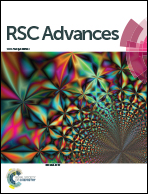Photosensitivity responses of Sagittula stellata probed by FTIR, fluorescence and Raman microspectroscopy
Abstract
Raman, fluorescence and FTIR experiments of prestine Sagittula stellata and Sagittula stellata–metal ion complexes grown in light and in dark were performed to probe the photosensitivity response of the cellular components in the marine bacterium. In the presence of Cu(II) and Zn(II) the frequency shifts of PO2−, C–O–C and C–O–P vibrations indicate metal binding to nucleic acids, carbohydrates and polysaccharides. We assign the observed bands in the 514.1 nm Raman spectra of the prestine S. Stellata and of the extracted carotenoids to the C![[double bond, length as m-dash]](https://www.rsc.org/images/entities/char_e001.gif) C and C–C stretching vibrations. The fluorescence excitation–emission matrix (EEM) of S. stellata in light, dark and in the presence of metal ions are reported and compared with the Raman and FTIR data. The novel ability of S. stellata although heterotrophic, to show light-dependent metal binding ability may be an important feature property that maintains a stable heterotroph–prototroph interaction and a dynamic system.
C and C–C stretching vibrations. The fluorescence excitation–emission matrix (EEM) of S. stellata in light, dark and in the presence of metal ions are reported and compared with the Raman and FTIR data. The novel ability of S. stellata although heterotrophic, to show light-dependent metal binding ability may be an important feature property that maintains a stable heterotroph–prototroph interaction and a dynamic system.



 Please wait while we load your content...
Please wait while we load your content...